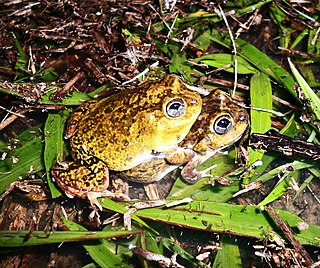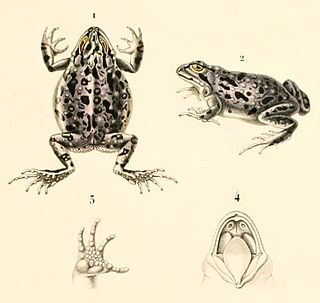
Pleurodema is a genus of leptodactylid frogs from South America. They are sometimes known under the common name four-eyed frogs, although this name can also refer to a particular species, Pleurodema bibroni. The common name is a reference to two inguinal poison glands that resemble eyes. When threatened, the frog lowers its head and raises its rear. When the frog adopts this posture, the poison glands are also raised toward the predator. The predator may also confuse the frog's raised posterior for the head of a larger animal.
The Sudanian grass rat is a species of rodent in the family Muridae. It is found in Burkina Faso, Guinea-Bissau, Mali, Niger, Senegal, possibly Benin, possibly Ivory Coast, possibly Ghana, possibly Guinea, and possibly Togo. Its natural habitats are subtropical or tropical dry shrubland, subtropical or tropical moist shrubland, subtropical or tropical dry lowland grassland, subtropical or tropical seasonally wet or flooded lowland grassland, arable land, pastureland, rural gardens, irrigated land, seasonally flooded agricultural land, and canals and ditches.

The four-striped grass mouse or four-striped grass rat, is a species of rodent in the family Muridae.

The tailless tenrec, also known as the common tenrec, is a species of mammal in the family Tenrecidae. It is the only member of the genus Tenrec. Native to Madagascar, it is also found in the Comoros, Mauritius, Réunion, and Seychelles, where it has been introduced. Its natural habitats are subtropical or tropical dry forest, subtropical or tropical moist lowland forest, subtropical or tropical moist montane forest, dry savanna, moist savanna, subtropical or tropical dry shrubland, subtropical or tropical moist shrubland, subtropical or tropical high-altitude shrubland, subtropical or tropical dry lowland grassland, subtropical or tropical high-altitude grassland, arable land, pastureland, plantations, rural gardens, and urban areas.
Pleurodema bibroni is a species of frog in the family Leptodactylidae. Its common name is four-eyed frog, although this name can also refer to the genus Pleurodema in general. The common name refers to two inguinal poison glands that resemble eyes. When threatened, the frog lowers its head and raises its rear. When the frog adopts this posture the poison glands are also raised toward the predator. The predator may also confuse the frog's raised posterior for the head of a larger animal.
Pleurodema borellii is a species of frog in the family Leptodactylidae. It is found in northwestern Argentina and southern Bolivia. The taxonomic status of this species is uncertain, and it may be a junior synonym of Pleurodema cinerea. It is abundant in Argentina, occurring in the Chaco-Yungas transition and montane grasslands on the eastern slopes of the Andes. Reproduction takes place in small permanent and temporary pools where pairs build floating foam nests. It is also found in disturbed habitats, including urban areas. No major threats to this species have been identified.

The Colombian four-eyed frog is a species of frog in the family Leptodactylidae. It is found in an area stretching from Guyana and northern Brazil through Venezuela and Colombia into Panama as well as the Netherlands Antilles.
Pleurodema bufoninum, the large four-eyed frog or sapo de cuatro ojos grandes, is a species of frog in the family Leptodactylidae. It is found in Argentina and Chile. Its natural habitats are subantarctic forests, temperate forests, subantarctic shrubland, temperate shrubland, subtropical or tropical dry shrubland, subantarctic grassland, temperate grassland, intermittent rivers, swamps, intermittent freshwater marshes, arable land, rural gardens, ponds, and open excavations. The common name "four-eyed frog" refers to two inguinal poison glands that resemble eyes. When threatened, the frog lowers its head and raises its rear. When the frog adopts this posture, the poison glands are also raised toward the predator. The predator may also confuse the frog's raised posterior for the head of a larger animal.

Pleurodema cinereum is a species of frog in the family Leptodactylidae. It is found in the Andes in northwestern Argentina, Bolivia, and southeastern Peru. Its common name is Juliaca four-eyed frog, after its type locality, Juliaca. Pleurodema borellii is possibly a junior synonym of this species.

Pleurodema diplolister, the Peters' four-eyed frog, is a species of frog in the family Leptodactylidae. It is endemic to Brazil. Its natural habitats are dry savanna, moist savanna, subtropical or tropical dry shrubland, subtropical or tropical dry lowland grassland, intermittent freshwater marshes, sandy shores, and pastureland. It is threatened by habitat loss. The common name "four-eyed frog" refers to two inguinal poison glands that resemble eyes. When threatened, the frog lowers its head and raises its rear. When the frog adopts this posture, the poison glands are also raised toward the predator. The predator may also confuse the frog's raised posterior for the head of a larger animal.
Pleurodema guayapae is a species of frog in the family Leptodactylidae. It is found in Argentina and Bolivia. Its natural habitats are temperate shrubland, subtropical or tropical dry shrubland, subtropical or tropical dry lowland grassland, subtropical or tropical seasonally wet or flooded lowland grassland, intermittent freshwater marshes, and pastureland.
Pleurodema kriegi is a species of frog in the family Leptodactylidae. It is endemic to Argentina. Its natural habitats are temperate grassland, intermittent freshwater marshes, and rocky areas. It is threatened by habitat loss.

Pleurodema marmoratum is a species of frog in the family Leptodactylidae. It is found in Argentina, Bolivia, Chile, and Peru. Its natural habitats are subtropical or tropical high-altitude shrubland, subtropical or tropical high-altitude grassland, rivers, swamps, freshwater marshes, intermittent freshwater marshes, arable land, pastureland, and irrigated land.
Pleurodema nebulosum is a species of frog in the family Leptodactylidae. It is endemic to Argentina. Its natural habitats are temperate shrubland, subtropical or tropical dry shrubland, temperate grassland, subtropical or tropical dry lowland grassland, subtropical or tropical seasonally wet or flooded lowland grassland, subtropical or tropical high-altitude grassland, intermittent freshwater marshes, arable land, pastureland, ponds, irrigated land, and seasonally flooded agricultural land.

Pleurodema thaul, the chilean four-eyed frog is a species of frog in the family Leptodactylidae. It is found in Argentina and Chile. Its natural habitats are subantarctic forests, temperate forests, temperate shrubland, temperate grassland, rivers, intermittent rivers, swamps, freshwater lakes, intermittent freshwater lakes, freshwater marshes, intermittent freshwater marshes, pastureland, plantations, rural gardens, urban areas, water storage areas, ponds, open excavations, sewage treatment areas, irrigated land, seasonally flooded agricultural land, and introduced vegetation. It is threatened by habitat loss.
Pleurodema somuncurense is a species of frog in the family Leptodactylidae. It is endemic to the Somuncura Plateau in Patagonia, Argentina.

The small disked frog or swamp frog is a species of frog in the family Dicroglossidae. It is endemic to the Philippines.
Ptychadena neumanni is a species of frog in the family Ptychadenidae. It is endemic to Ethiopia.

The Greenwood's shrew is a species of mammal in the family Soricidae. It is endemic to Somalia. Its natural habitats are subtropical or tropical moist lowland forest, dry savanna, subtropical or tropical dry shrubland, and arable land.
Pleurodema cordobae is a species of frog in the family Leptodactylidae. It is endemic to the Sierras de Córdoba of Argentina. This endemic species also resides with the highly similar species, Pleurodema kriegi. P. cordobae exhibits particular characteristics that differentiate it from other frogs in the Pleurodema genus, including the fact that the species is octoploid, as compared to the P. kriegi and Pleurodema bibroni, which are tetraploid. P. cordobae inhabits temporary and semi-permanent ponds. As this species is only found in isolated locations such as the Sierra Grande, little is known about its very limited population.









